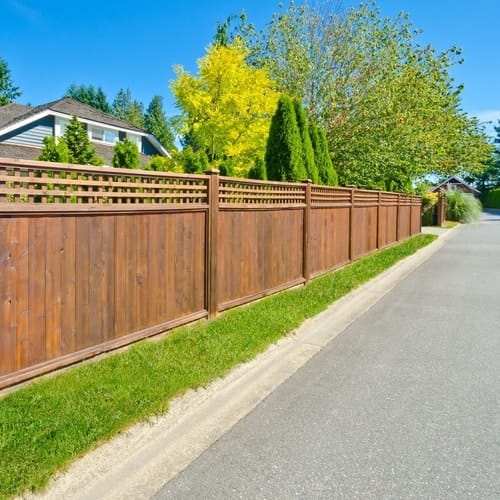Just How to Select the Right Fence Discoloration for Your Building
When it pertains to enhancing the appearance and resilience of your home's fence, choosing the best stain is a critical choice that calls for cautious factor to consider. With a myriad of choices available on the market, each catering to different timber kinds, colors, and transparency degrees, the procedure can swiftly end up being frustrating. Making an educated selection can dramatically influence the general aesthetic appeals and longevity of your fence. Just how can you make certain that you pick the best fencing tarnish that lines up with your residential or commercial property's style and upkeep demands? Let's check out some crucial variables to lead you in this decision-making process.
Comprehending Wood Types
To choose the appropriate fence stain, it is important to have a detailed understanding of the numerous types of timber generally made use of for fence. The choice of timber plays a crucial duty in establishing the longevity and total aesthetic appeals of the fencing. Cedar is a prominent choice due to its all-natural resistance to decay and bugs, making it a sturdy choice for exterior frameworks. Pine is one more common timber made use of in fence, known for its affordability and convenience of discoloration. Ache is much more susceptible to warping and decomposing compared to cedar. Redwood is a high-end option recognized for its striking look and natural sturdiness, though it features a higher price. When choosing a fence stain, it is essential to consider the kind of timber being used to guarantee compatibility and optimal protection. Comprehending the attributes of different timber types will certainly aid you make a notified decision when it pertains to picking the ideal fence tarnish for your building - Nashville Fence Staining Services.
Picking the Right Shade
Choosing a proper color for your fencing stain is a crucial decision that considerably impacts the overall aesthetic allure of your building. Lighter colors such as whites or light grays can make a fence show up bigger and add a touch of beauty to your residential or commercial property. Inevitably, the right shade choice will improve the charm of your fencing and boost the general aesthetic appeal of your home.

Thinking About Openness Degrees
When choosing the best color for your fencing stain, one more vital element to consider is the degree of openness that will finest fit your property's aesthetic and upkeep needs. Transparency degrees in fence stains usually fall right into three groups: transparent, semi-transparent, and solid. Take into consideration the level of direct exposure your fence deals with, the preferred maintenance regularity, and the aesthetic you want to achieve when selecting the appropriate openness degree for your fence discolor.
Evaluating Maintenance Requirements
Thinking about the long life and maintenance of your fence, assessing the upkeep needs is crucial in figuring out the most appropriate fencing tarnish for your residential or commercial property. The level of maintenance required for your fence can differ relying on factors such as the kind of wood, climate condition in your area, and your personal preferences.
When evaluating maintenance needs, it is essential to consider the longevity of the fencing stain. Some stains need more regular reapplication than others, so choosing a stain with a much longer life expectancy can help in reducing the total upkeep needs of your fencing (Fence Staining). Furthermore, factors such as resistance to UV rays, water, and mold can impact how commonly you require to re-stain your fence

Checking Samples Before Application
Prior to applying any type of fence tarnish, it is a good idea to conduct example examinations to make certain compatibility with the timber and wanted aesthetic result (Fence Staining). Checking samples enables you to examine just how the tarnish will communicate with the specific type of wood used in your fencing, as different woods can take in stains in different ways. To start, select a tiny unnoticeable location of the fence to use the discolor samples. It is recommended to check multiple discolor alternatives on this section to compare colors and finishes. Think about just how the tarnish looks when dry, as it may appear different from its damp application. In addition, observe exactly how the stain complements the existing aspects in your outdoor space, such as landscaping or the color of your home. Bear in mind of this link exactly how the stain holds up to climate condition like sunshine and dampness. By examining examples prior to full application, you can make an educated decision that boosts the total look of your residential or commercial property while safeguarding the wood efficiently.
Final Thought
In final thought, choosing the ideal fence stain for your residential or commercial property includes recognizing the wood kind, selecting the best shade, taking into consideration openness levels, examining maintenance needs, and testing examples before application (Fence Staining). By taking these variables right into factor to consider, you can make certain that your fencing discolor complements your building while giving the essential defense and toughness. Make a notified choice to improve the look and long life of your fence